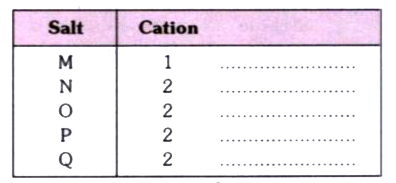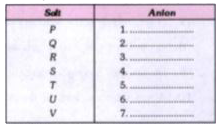The colour of the precipitate formed when ferrous ions react with ammonium hydroxide solution
Blue
Reddish brown
Dirty green
White
The correct Answer is:C
To determine the color of the precipitate formed when ferrous ions react with ammonium hydroxide solution, follow these steps:
1. Identify the Reactants:
- The reactants in this reaction are ferrous ions (Fe²⁺) and ammonium hydroxide (NH₄OH).
2. Write the Chemical Reaction:
- When ferrous ions react with ammonium hydroxide, the reaction can be represented as:
Fe2++2NH4OH→Fe(OH)2↓+2NH+4
- Here, Fe(OH)₂ is the precipitate formed.
3. Identify the Precipitate:
- The precipitate formed in this reaction is ferrous hydroxide, represented as Fe(OH)₂.
4. Determine the Color of the Precipitate:
- The color of the precipitate Fe(OH)₂ is known to be dirty green.
5. Conclusion:
- Therefore, the color of the precipitate formed when ferrous ions react with ammonium hydroxide solution is dirty green.
- The reactants in this reaction are ferrous ions (Fe²⁺) and ammonium hydroxide (NH₄OH).
- When ferrous ions react with ammonium hydroxide, the reaction can be represented as:
Fe2++2NH4OH→Fe(OH)2↓+2NH+4
- Here, Fe(OH)₂ is the precipitate formed.
- The precipitate formed in this reaction is ferrous hydroxide, represented as Fe(OH)₂.
- The color of the precipitate Fe(OH)₂ is known to be dirty green.
- Therefore, the color of the precipitate formed when ferrous ions react with ammonium hydroxide solution is dirty green.
Topper's Solved these Questions
Similar Questions
Identify the anion present in the following compound : When a solution of compound Y is treated with silver nitrate solution a white precipitate is obtained which is soluble in excess of ammonium hydroxide solution.
View SolutionA black solid P dissolves in warm and dilute HCI to form greenish yellow solution Q, but does not give off any gas. The solution Q on treating with ammonium hydroxide forms bluish white precipitates of R. The precipitates of R dissolve in excess of ammonium hydroxide. solution to form deep-blue colouration. Identify solid P and bluish white precipitates of R.
Write equations for action of excess of ammonium hydroxide on R.
View SolutionA black solid P dissolves in warm and dilute HCI to form greenish blue solution Q, but does not give off any gas. The solution Q on treating with ammonium hydroxide forms bluish white precipitates of R. The precipitates of R dissolve in excess of ammonium hydroxide. solution to form deep-blue colouration. Identify solid P and bluish white precipitates of R.
Write equations for
Action of less amount of ammonium hydroxide on Q.
View SolutionSalts M, N, O, P and Q undergo reactiom (i) to (v) respectively.
Identify the cation present in these salts on the basis of these reaction. Tabulate your answer in the format given below.
1. When sodium hydroxide solution is added to the salt M, and heated strongly a colourless gas with a pungent smell is evolved which turm red litmus paper blue and gives dense white fumes with a moist glass rod with hydrochloric acid.
2. Addition of dilute hydrochloric acid to a solution of N gives a thick white precipitate which is soluble in hot water.
3. When ammonium hydroxide solution is added to the solution of 0 a light blue precipitate is obtained which is soluble in excess of ammonium hydroxide to form an inteme deep blue solution.
4. When ammonium hydroxide solution is added to the solution of P reddish brown (mustard colour) precipitate is obtained which ,is insoluble even in the excess of ammonium hydroxide solution.
5. When sodium hydroxide solution is added to the solution of Q a which coloured gelatinous precipitate is obtained which is soluble in excess of sodium hydroxide to form a clear solution

View SolutionSalts P, Q,R,S,T,U and V undergo reactions (i) to (vii) respectively. Identify the cation present in these salts on the basis of these reactions. Tabulate your answer in the formate given below.
(i) When the salt Pis heated with sodium hydroxide solution a vigorous reaction takes place and a colourless gas is evolved with a pungent and suffocating smell that brings tears in our eyes. The evolved gas gives dense white fumes with a moist glass rod depped with hydrochloric acid.
(ii) Addition of sodium hydroxide solution to a solution of salt Q gives a thick white precipitae which is soluble in excess of sodium hydroxide solution to form a clear solution.
(iii) Addition of ammonium hydroxide solution to a solution of salt R gives a dark blue precipitate which is soluble is excess of ammonium hydroxide solution to form an intense deep blue solution.
(iv) Addition of ammonium hydroxide solution to a solution of 5 gives a dirty green [bottle green] precipitate which is insoluble even in the excess of ammonium hydroxide solution.
(v) Addition of ammonium hydroxide solution to a solution of T gives a reddish brown (rust precipitate] precipitate which is insoluble even in the excess of ammonium hydroxide solution.
(vi) Addition of ammonium hydroxide solution to a solution of V gives a geletaneous white precipitate which is soluble in excess of ammonium hydroxide solution to form a clear solution.
(vii) Addition of ammonium hydroxide solution to a solution of V gives no precipitate but it gives a chalky white precipitate with sodium hydroxide solution which is insoluble even in the excess of sodium hydroxide solution.

View SolutionColour of precipitates obtained when cadmium chloride reacts with hydrogen sulphide.
View SolutionBurning magnesium ribbon is taken in gas P when it form a salt R. The salt R dissolves in water and gives curdy white precipitate with silver nitrate solution. This precipitate is soluble in excess of ammonium hydroxide solution. Name the gas P and salt R. State the chemical reaction between P and magnesium
View SolutionThe colour of precipitate obtained when ammonium hydroxide is added to ferric chloride is ……………………
View SolutionComplete the following using the correct word from those given in the brackets.
On adding ammonium hydroxide to a solution of calcium nitrate, a white precipit is …………...(formed/not formed)
View SolutionThe nitrogen compound that is formed when NH4Cl reacts with sodium hydroxide is
View Solution
